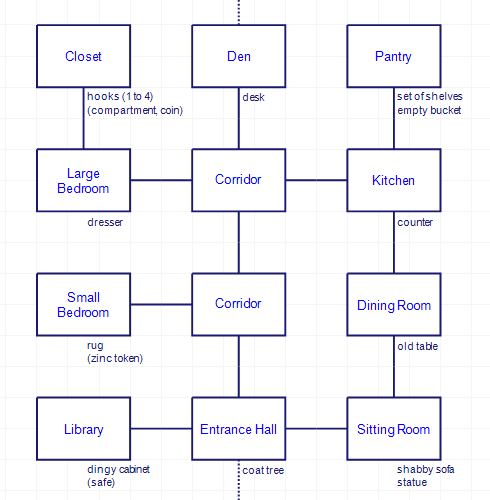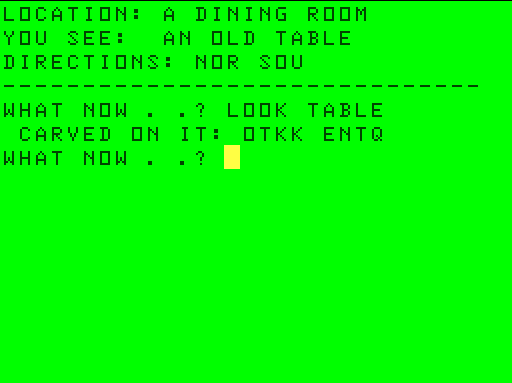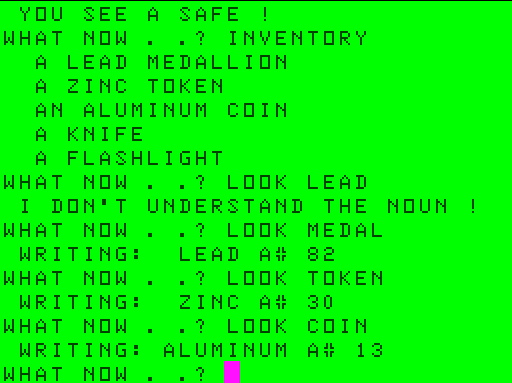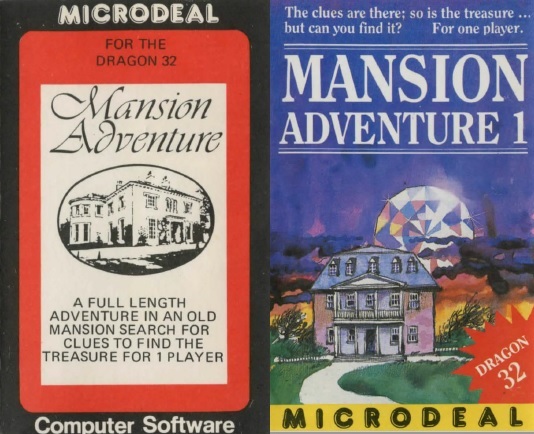
Recently I played a game by John Olson of Kansas (as opposed to John Olsen of Oregon), Island Adventure. Purely by random chance another Olson game came up next on my list, except I was somewhat baffled at first because my brain interpreted it as Oregon John; that is, I was expecting a game with complex coding, interlocking puzzles, high enough difficulty to give trouble, and a scenario where every item is important. No, this is instead Kansas John, the one with simple coding, lots of items that don’t mean or do anything, and some of the most straightforward adventuring I’ve played.
Honestly, in its original context, it isn’t bad: it was published in Chromasette, sister publication to CLOAD. CLOAD was for the TRS-80, Chromasette for Tandy’s follow-up, the Color Computer. (I’ll get back to what I mean about context later.)

Chromasette tapes are the blue stacks to the right. From Z-JunkEmporium.
It also — despite being founded by the same person who had been editor-in-chief of CLOAD since 1980, David Lagerquist — is a lot rarer than CLOAD, and the picture above is the only one I’ve found of any genuine physical Chromasette tapes. The issue at question here is January 1981, which includes an animated line movement demo as the “cover art”.

The premise lands you in a mansion where you need to retrieve a diamond.

You start with a pry bar and need to bust your way in.

Inside there are lots of shabby furnishings which have various hidden items, and really the big task is trying to nudge anything at all loose.

The coat tree hides nothing.
The main challenge is the verbs being picky.

For example, to get the hidden item out of the rug at the Small Bedroom, you can’t just LOOK at it, or MOVE it, you have to completely TAKE it. To be fair, this gets you a zinc token which might be a bit small to see just by moving.
A table gives a cryptic hint: OTKK ENTQ.

The letters just shift one ahead to be PULL FOUR. There’s a closet with four hooks and PULL FOUR reveals a secret compartment with an aluminum coin.
A third artifact, a medallion, is hidden in a cheap statue.

The initial instructions mention BREAK STATUE. I always love it when instructions give a completely explicit hint about an action in the game.
There’s a safe you can find by moving a cabinet, and the three things I mentioned (coin, medallion, token) give “atomic numbers” that can be used to open the safe.

There is, as far as I can find, no hint as to what order to put the numbers in. Normally trying all six combos would be no sweat, but entering the wrong combination kills you. I got it right on the fifth try (13/82/30).


The items are a key and a notebook; the notebook gives you the hint to KSED KCIK (read backwards).

Winning then is a matter of making sure you don’t pull levers or push buttons.

For example, a tempting red button floods the passage you’re in.

There’s another trap when you reach the diamond.

Going through with the action above without using the key first drops you in a trapdoor. You need to insert the key and then the diamond is safe to take, and that’s it! There’s no more twists.


So back to context: this was a single game tossed on a monthly collection, and as such, despite it being a 10-15 minute game at most, didn’t “feel” like a rip-off. Despite a gaggle of useless objects like a flashlight and a nail file the extra parts had some comedy mixed in came off as intentional rather than bad choices.

The bucket does nothing either. In a walkthrough all you need is the key, since the code to the safe doesn’t change.
However, this wasn’t the only format the game was published in! It was published by the UK company Microdeal more than once.

We’ll see Microdeal again as this was the first in a series; I’ll get more into their history on a revisit.
So this was fun enough for a short game, but I’m not sure how I’d feel if I bought it standalone expecting a serious experience. Fortunately, I got a reaction from someone writing in the 80s so I can clock how one person felt:
Microdeal have inevitably produced a series of adventures for the Dragon, including Escape, Flipper, and Mansion Adventure, or at least they call them adventure games, Personally the only one I thought was of lasting interest was the Mansion Adventure, but then we all have our different tastes.
— Exploring Adventures on the Dragon, Peter Gerrard, published June 1984
This honestly seems inscrutable to me — the game was enjoyable enough for what it was but “lasting interest”? On the other hand, in addition to the multiple Microdeal versions there was a Plus 4 port and an (unofficial) VIC-20 port and in modern times it has been ported twice more (once by Barry Hart, once by Jim Gerrie) so maybe the utter simplicity is the appeal.

A mouse and a spider sometimes appear. They’re just for scenery.
Addendum: IF you chip away the deathtraps and dealing with finding the right search-verb, there are really three puzzles: the OTKK ENTQ code, entering the atomic codes, and the KSED KCIK puzzle. This makes it essentially a proto-version of the style of adventure with no object manipulations of note but more a focus on self-contained puzzles (like The Daedalus Encounter or Safecracker: The Ultimate Puzzle Adventure). This does make the game of note in the innovation category and is perhaps why Mr. Gerrard indicated “lasting interest” in his brief review.
Coming up next: one more game that is straightforward and simple but for very different reasons than Mansion Adventure, followed by an ambitious Apple II game that wants you to die.